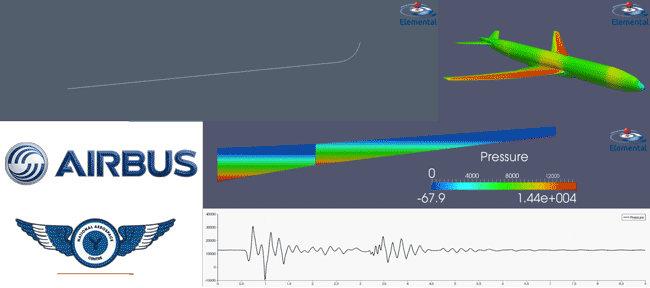Toward a Non-linear Full Aircraft Model (FAM)
During the design phase of an aircraft, accurate load prediction is critical to ensure safe flight. Aircraft loads and responses are required for over 100,000 operating conditions, as required by European Aviation Space Agency regulations. Therefore, an accurate and time-efficient modelling technology is needed. For this purpose, full aircraft models (FAMs) are used which account for dominant non-linear phenomenon viz. non-linear structural flexing, transonic shocks and internal fuel sloshing.
The work to be being done in support of the above takes a comprehensive approach in developing tailored modelling technologies which range from full order to reduced order non-linear aeroelastic models. Non-linear effects accounted for include transonic flows and geometrically non-linear structural deflections. It is demonstrated that rapid yet accurate loads calculations may be achieved if using the aforementioned techniques in a co-ordinated manner.
Comprehensive High-Resolution Aeroelastic Model - William Liw Tat Man, Donovan Changfoot, Javon Farao Changfoot, Javon Farao
This work being done entails the development of a high-resolution fluid model coupled with a non-linear structural wing model. The unsteady 3D viscous compressible code Elemental was used for the flow modelling. The gust was applied to the domain by using the Split Velocity Method(SVM) and the geometry investigated was the 3D NASA Common Research Model(CRM). An under-resolved viscous calculation is employed via application of SBP-SAT boundary conditions. Part of the research leading to this work was supported by the AEROGUST project (funded by the European Commission under grant agreement number 636053). The partners in AEROGUST are: University of Bristol, INRIA, NLR, DLR, University of Cape Town, NUMECA, Optimad Engineering S.r.l., University of Liverpool, Airbus Defence and Space, Dassault Aviation, Piaggio Aerospace and Valeol.

Accurate Non-linear Reduced-Order Modelling - Javon Farao
Javon Farao aims to represent the dominant FAM components by reduced-order models (ROMs) that decrease the size of the problem whilst maintaining the dominant physics of the important phenomena. Although a successful linear FAM is in operation there is a current interest in the non-linear ROMs to improve the accuracy. This entails developing advanced non-linear ROMs for the structure and fuel slosh from fully-coupled higher-order simulations. The non-linear Elemental FAM will then be employed to identify worst case slosh loads which may then be subjected to higher resolution calculations.
The primary industrial benefits include:
- Establishing a novel FAM which accounts for nonlinear structural and slosh dynamics.
- Insight into the loads resulting from the non-linear structure and fuel slosh interaction.
- Lighter aircraft wings may be designed resulting in design cost and fuel savings.
